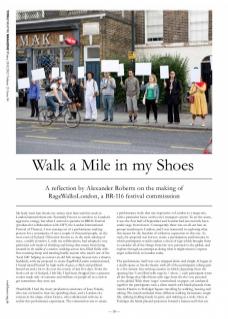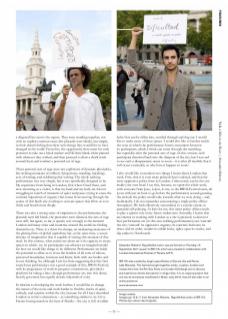My body went into shock, my senses were bare and this week in London battered them raw. Normally I’m not so sensitive to London’s aggressive energy, but when I arrived to partake in BR116-Festival (produced in collaboration with LIFT, the London International Festival of Theatre), I was coming out of a performance-making process for a community of just a couple of thousand people, on the west coast of Iceland. Otherwise known as, in the most adoring of ways, a middle of nowhere. I, with my collaborators, had adopted a very particular soft mode of thinking and being that comes from being situated in the middle of a nowhere, walking across lava-filled fields with free-roaming sheep and meeting hardly anyone who wasn’t one of the ‘local folk’ helping us convert an old fish storage freezer into a theatre. Suddenly, with my proposal to create RageWalksLondon commissioned, I found myself buried by high walls of grey, a thick and polluted humid air and a lot to do over the course of just five days. From the fresh cool air of Iceland, I felt like I had been dropped into a pressure cooker made only of concrete and millions of people all in a rush to get somewhere they were not.
Thankfully I had the trusty production assistance of Joao Toleda, who was on hand to hear my sprawling ideas, and a London city veteran in the shape of Jon Grieve, who collaborated with me to realise this performance experiment. The commission was to create a performance work that was responsive to London as a mega-city, with a particular focus on the city’s transport system. To set the scene, it was the first half of September and London had just recently been under siege from rioters. Consequently there was an all-out ban on groups marching in London, and I was interested in exploring what this meant for the freedom of collective expression in this city. As such, the proposal was born to create a participatory performance in which participants would conduct a ritual of rage which brought them to consider all of the things from the very personal to the global, and explore through an-attempt-at-doing what it might mean to express anger collectively in London today.
The performance itself was very stripped down and simple. It began in a studio space at Arcola theatre with all of the participants taking part in a five minute free-writing exercise in which, departing from the opening line ‘I am filled with rage by / when...’, each participant wrote all the things that filled them with rage from the the very personal to the global. With these ‘rages’ externalised on paper, yet unshared, together the participants took a silent march with blank placards from Arcola Theatre to Trafalgar Square travelling by walking, bussing and tubing. The march included three different walking formations: single file, walking holding hands in pairs, and walking as a mob. Once at Trafalgar the blank placard protesters formed a human wall that cut a diagonal line across the square. They were standing together, not with an explicit common cause (the placards were blank), but simply, in their shared feeling that there were things they would like to have changed in the world. From this, the opportunity then came for each protester to take out a black marker and fill their blank white placard with whatever they wished, and then proceed to draw a chalk circle around them and conduct a personal act of rage.
These personal acts of rage were not explosions of dynamic physicality, but striking moments of stillness (lying down, standing, kneeling), acts of writing, and exhibiting that writing. The whole walking performance was very simple, but it was specifically designed to be. My experience from being in London, first when I lived there, and now returning as a visitor, is that my head and my body are forever struggling in search of moments of quiet and pause: trying to cease the constant imposition of urgency that comes from moving through the centre of this brash city; looking to activate spaces that allow us to to think and breath more deeply.
There was also a strong sense of emptiness to the performance; the placards were left blank, the protesters were silenced, the acts of rage were still, but again, to me, it speaks very strongly to the moment London and many cities and countries around the world are finding themselves in. There is a thirst for change, an awakening awareness of the glaring flaws of global capitalism, but, at the same time, a severe absence of imagination that is capable of seizing this moment of dire need. In this context, what excites me about art is its capacity to create spaces in which, we, its participants can advance an imagined model for how we would like things to be different. Performance art holds the potential to allow us to cross the borders of all sorts of taboos, perceived boundaries, horizons and limits; both with our bodies and in our thinking. So, although I am far from suggesting that this first scratch run performance was a good example of this, BR116-Festival, with its programme of work-in-progress commissions, provided a platform for taking a bite, through performance art, into this dense, heavily governed, but equally chaotic labyrinth of a city.
In relation to developing the work further, I would like to change the nature of the route and work harder to find the cracks of quiet, solitude, and surprise within the city, because for all I have described London as in this commentary – as something similar to an Ali vs. Frazier boxing match in the heat of Manila – the city is full of rabbit holes that can be fallen into, crawled through and dug out. I would like to make more of these spaces. I would also like to further enrich the ways in which the performance fosters encounters between its participants, which I think can come through the marching, but especially after the personal acts of rage. In this version, each participant dissolved back into the diaspora of the city, but I was sad to see such a disappearance occur so soon – it is after all inevitable that it will occur eventually, so why have it happen so soon?
I also would like to mention two things I learnt about London that week. First, that it is even more policed than I realised, and that the most oppressive police force in London, I discovered, can be the one inside your own head. I say this, because, we spent the whole week, with everyone from Joao, to Jon, to me, to the BR116 Festival team, all (even with just an hour to go before the performance) second-guessing the attitude the police would take towards what we were doing – and, incidentally, I do not remember encountering a single police officer throughout. We had collectively succumbed, to a certain extent, to paranoid self-policing. At least for me, this inner police officer needs to play a quieter role in my future endeavours. Secondly, I learnt that my interest in working with London as a site is precisely to discover how performance art (in this case walking performances) can ‘unwork’ the city; ‘unwork’ its oppressive urgency; its concrete horizons; its chaos and its order; wander its rabbit holes, splice open its cracks, and dig under its floorboards.
Alexander Roberts’ RageWalksLondon was performed on Thursday 15 September 2011 as part of BR-116, which was created in collaboration with Londion International Festival of Theatre (LIFT).
BR-116 was curated by Jorge Lopes Ramos of Zecora Ura and Persis Jade Maravala. The festival brought together artists, curators, funders and researchers from the Rio-Sao Paulo and London-Edinburgh axis to discuss and experience artistic disruptions in mega-cities. It is an ongoing project that will see its next phase manifested in Brazil, early 2012, that will also take on an online presence.
www.zecoraura.com


